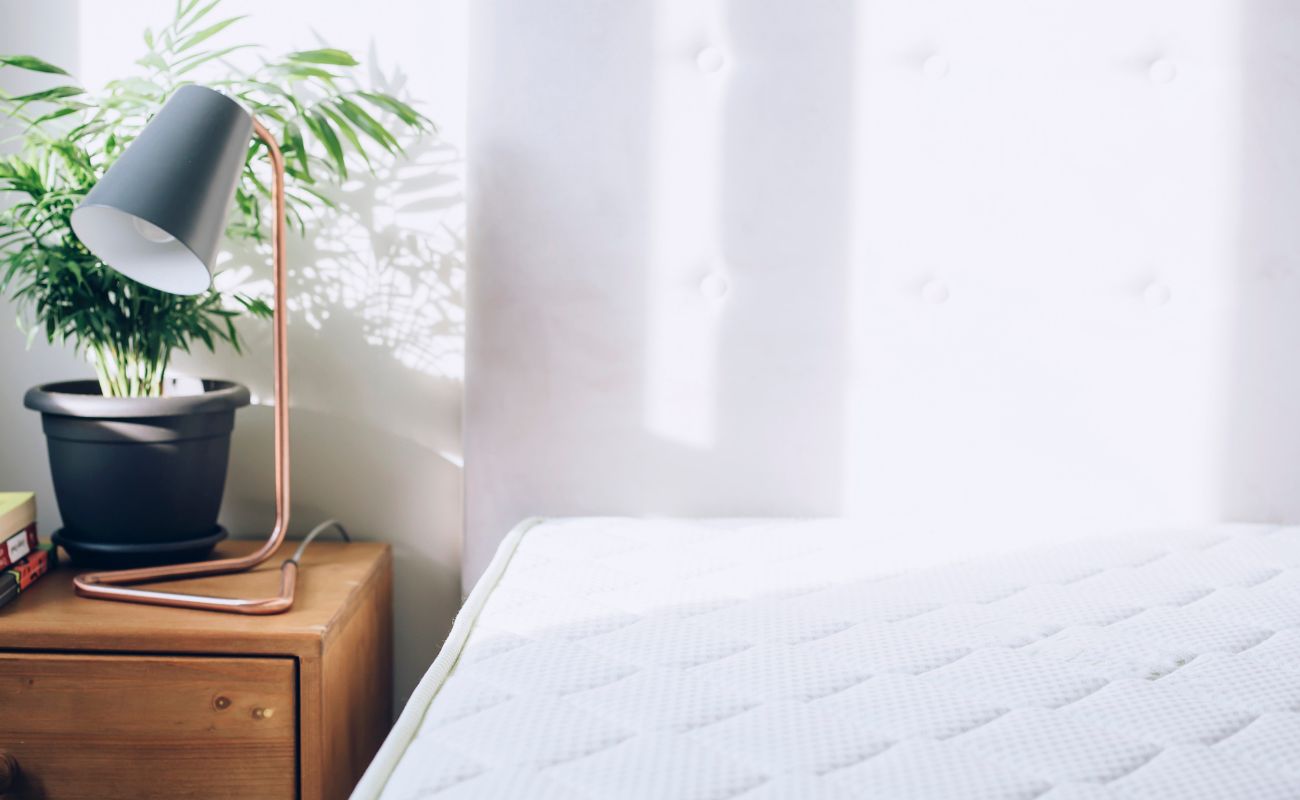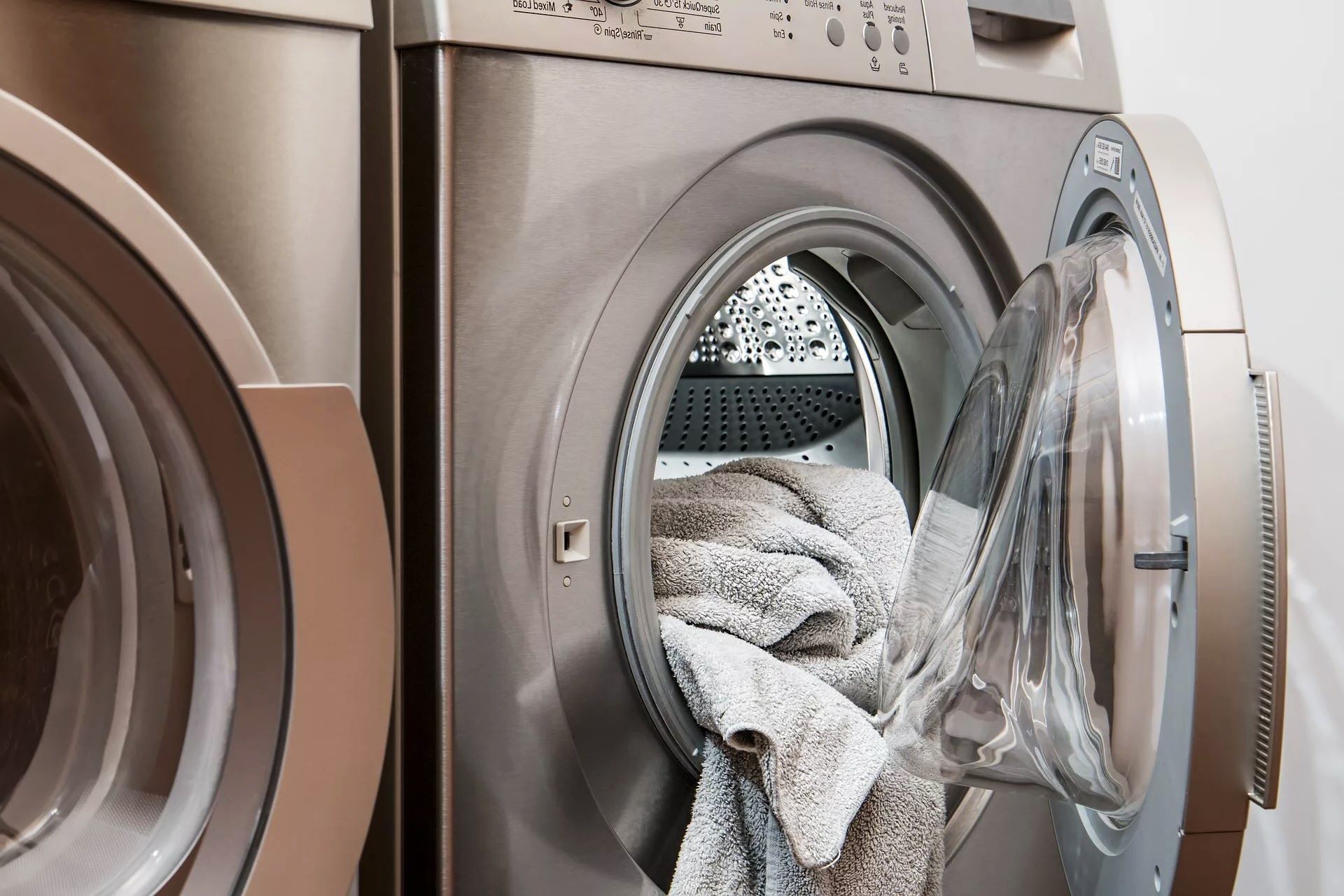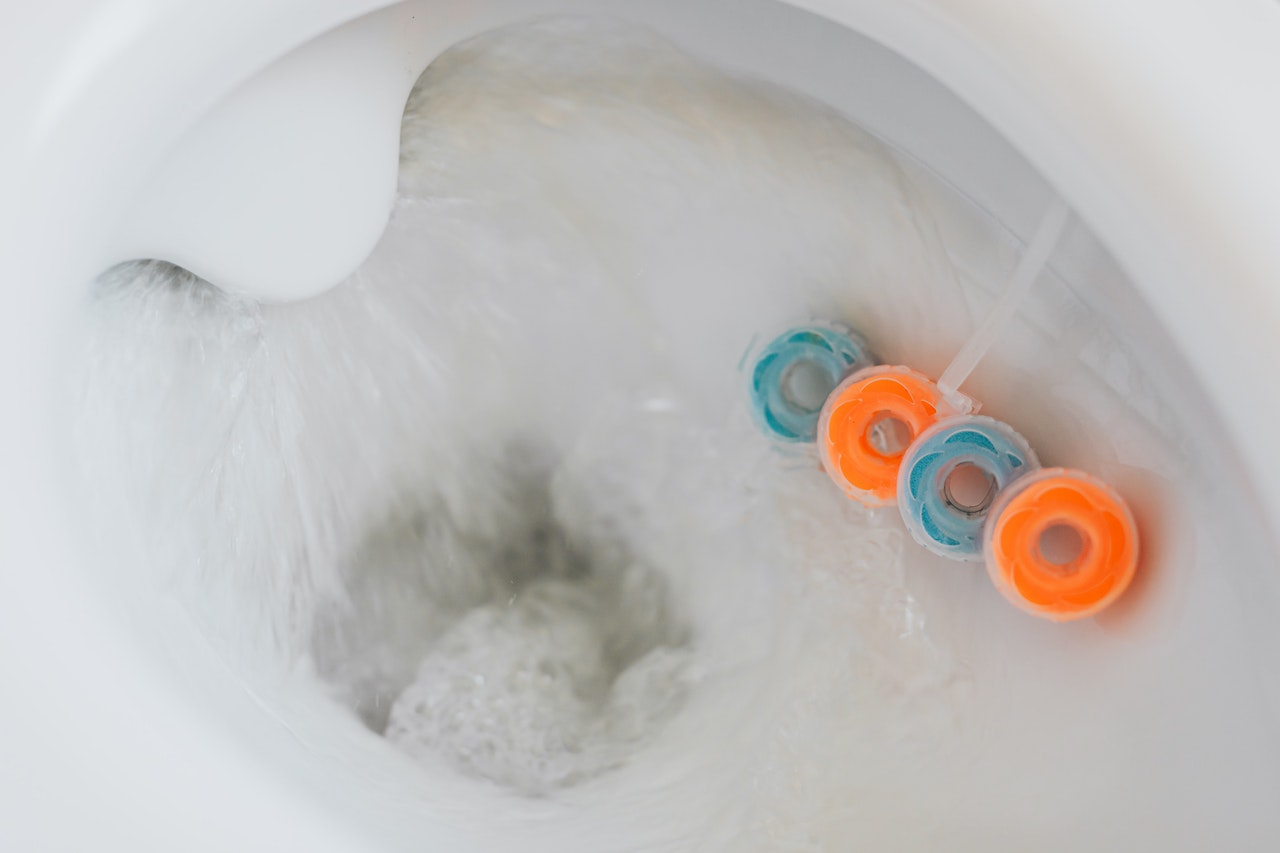Home>Furniture>Bedroom Furniture>Why Does My New Mattress Smell Like Chemicals


Bedroom Furniture
Why Does My New Mattress Smell Like Chemicals
Modified: February 19, 2024
Discover why your new bedroom furniture, specifically your mattress, may emit a chemical odor. Gain insights into common causes and learn how to eliminate the smell for a restful night's sleep.
(Many of the links in this article redirect to a specific reviewed product. Your purchase of these products through affiliate links helps to generate commission for Storables.com, at no extra cost. Learn more)
Introduction
There’s nothing quite like the feeling of a brand-new mattress. It’s like sleeping on a cloud and waking up refreshed and rejuvenated. However, sometimes that new mattress comes with an unexpected downside – a strong chemical smell. So, why does your new mattress smell like chemicals? In this article, we will explore the causes of the chemical smell in new mattresses, the health concerns associated with it, and provide some tips on how to minimize or eliminate the odor.
When you unbox a new mattress and are hit with a pungent chemical odor, it can be quite alarming. However, it’s important to understand that this smell is not uncommon in newly manufactured mattresses. In fact, most mattresses go through a manufacturing process that involves the use of various materials and chemicals, which can contribute to the lingering smell.
There are several reasons why your new mattress might emit a chemical odor. One of the main causes is the off-gassing of polyurethane foam. This type of foam is commonly used in mattresses for its comfort and support properties. However, it contains volatile organic compounds (VOCs) that can release gases as the foam decompresses, resulting in the characteristic chemical smell.
In addition to polyurethane foam, other mattress materials can also contribute to the chemical odor. These materials often contain volatile organic compounds (VOCs), such as adhesives, flame retardant chemicals, and synthetic fabrics. These VOCs can off-gas and give off a chemical smell, especially when the mattress is newly manufactured.
Another potential cause of the chemical smell in new mattresses is the storage and packaging process. Mattresses are often stored in warehouses or factories, where they can absorb odors from the environment or the packaging materials used. When you unwrap the mattress at home, these trapped odors are released, leading to the strong chemical smell.
While the chemical odor in a new mattress can be bothersome, it’s important to note that it usually dissipates over time. The duration and intensity of the smell can vary depending on factors such as the materials used, ventilation, and personal sensitivity. However, if you experience any persistent or concerning health symptoms, it’s advisable to consult a healthcare professional.
In the next sections, we will dive deeper into each of these causes and discuss the potential health concerns associated with chemical smells in mattresses. We will also provide some practical tips on how to minimize or eliminate the chemical odor, so you can enjoy a restful and healthy night’s sleep on your new mattress.
Key Takeaways:
- Choose a natural or organic mattress to minimize exposure to harmful chemicals and create a healthier, more sustainable sleep environment. Look for certifications like GOTS or GOLS for added assurance.
- Keep your bedroom well-ventilated and consider using a mattress protector to reduce exposure to chemical odors from a new mattress. Prioritize your well-being and comfort for a restful night’s sleep.
Read more: Why Does My AC Smell Like Vinegar
Causes of Chemical Smell in New Mattresses
When you purchase a new mattress, the last thing you want is for it to emit a strong chemical smell. However, there are several factors that can contribute to this unpleasant odor. Let’s take a closer look at the main causes:
1. Off-Gassing from Polyurethane Foam: Many mattresses are made with polyurethane foam, which is known for its comfort and support. However, polyurethane foam contains volatile organic compounds (VOCs) that can off-gas over time. When the foam decompresses, it releases these gases, resulting in the chemical smell. The intensity and duration of the smell can vary depending on the quality of the foam used and the ventilation in your room.
2. Volatile Organic Compounds (VOCs) in Mattress Materials: Aside from polyurethane foam, other materials used in mattresses can also contain VOCs. These compounds are often found in adhesives, flame retardant chemicals, and synthetic fabrics. When these materials are new, they can off-gas and release gases that contribute to the chemical smell. It’s important to note that the presence of VOCs in mattresses is regulated, but some individuals may still be sensitive to them.
3. Flame Retardant Chemicals: Flame retardant chemicals are commonly used in mattresses to meet fire safety regulations. However, these chemicals can emit a strong odor, especially in new mattresses. It is important to ensure that the mattress you purchase meets safety standards while considering the potential exposure to flame retardant chemicals.
4. Storage and Packaging Odor: Before reaching your bedroom, mattresses often go through a storage and packaging process. During this time, they can absorb odors from the environment, such as the warehouse or the materials used for packaging. When you unwrap the mattress at home, these trapped odors are released, contributing to the chemical smell. This type of odor is usually temporary and should dissipate over time.
Understanding these causes can help you make an informed decision when purchasing a new mattress. It’s important to keep in mind that the chemical smell is typically temporary and will improve with proper ventilation and time. In the next section, we will explore the potential health concerns associated with the chemical smell in new mattresses.
Off-Gassing from Polyurethane Foam
One of the major contributors to the chemical smell in new mattresses is the off-gassing of polyurethane foam. Polyurethane foam is a popular material used for its comfort and support in mattresses. However, it contains volatile organic compounds (VOCs) that can off-gas over time, releasing gases and creating that distinct chemical odor.
When polyurethane foam is produced, it undergoes a manufacturing process that involves the use of various chemicals, such as isocyanates, polyols, and flame retardant additives. These chemicals react and form the foam structure, but some of them can remain trapped within the foam and slowly release over time, leading to off-gassing.
The off-gassing process occurs when the mattress is first used or when it is exposed to warmth and pressure, such as when you lie down on it. As the foam decompresses, these trapped chemicals are released as gases, resulting in the strong chemical smell that many people experience with new mattresses.
The duration and intensity of the off-gassing can vary depending on several factors, including the quality of the foam used and the ventilation in the room. In some cases, the smell may dissipate within a few days or weeks, while in other cases, it may take several months for the odor to fully subside.
It’s important to note that the off-gassing of polyurethane foam is generally considered to be a minor health concern. The levels of VOCs released from mattresses are typically low and within safety standards. However, some individuals may be more sensitive to these chemicals and may experience symptoms such as headaches, nausea, or respiratory irritation.
If you are concerned about the off-gassing from polyurethane foam, there are steps you can take to minimize exposure to the chemicals. One option is to choose mattresses that are certified as low-VOC or have passed third-party certifications for their emissions. These certifications ensure that the mattress meets certain standards for indoor air quality.
In addition, you can also allow your new mattress to “air out” before using it. Remove any wrapping or packaging materials and place the mattress in a well-ventilated room for a few days. This will help to accelerate the off-gassing process and allow any trapped chemicals to dissipate more quickly.
Overall, while off-gassing from polyurethane foam can contribute to the chemical smell in new mattresses, it is typically a temporary issue that improves over time. By taking proactive steps to minimize exposure and ensuring proper ventilation, you can enjoy the comfort of your new mattress without being overwhelmed by the chemical odor.
Volatile Organic Compounds (VOCs) in Mattress Materials
Aside from polyurethane foam, there are other mattress materials that can contribute to the chemical smell in new mattresses. These materials often contain volatile organic compounds (VOCs), which are chemicals that can easily evaporate at room temperature and release gases into the air.
One common source of VOCs in mattresses is the adhesive used to bond different layers of the mattress together. Adhesives contain solvents that can emit VOCs as they dry and cure. These VOCs can contribute to the chemical odor that is often noticeable when a new mattress is unwrapped.
In addition to adhesives, flame retardant chemicals can also be a source of VOCs in mattresses. Flame retardants are added to mattresses to meet fire safety regulations. However, some of these chemicals can release gases and contribute to the chemical smell. It’s important to note that there are different types of flame retardants used in mattresses, and some are considered to have lower VOC emissions compared to others.
Furthermore, synthetic fabrics used for covers and upholstery in mattresses can also contain VOCs. Synthetic materials, such as polyester or nylon, are often treated with chemicals during the manufacturing process, which can off-gas and create an odor. Natural fabrics, like cotton or wool, are generally considered to have lower VOC emissions compared to synthetic materials.
It’s worth mentioning that there have been efforts in the mattress industry to reduce VOC emissions and offer lower chemical exposure options. Some mattress manufacturers now offer mattresses with certifications such as the CertiPUR-US® certification, which ensures that the foam used in the mattress meets specific standards for VOC emissions and other health and environmental criteria.
If you are concerned about VOCs in your new mattress, one option is to look for mattresses that have been independently certified for low VOC emissions. These certifications indicate that the mattress has undergone testing to ensure it meets specific criteria for indoor air quality. Additionally, you can also choose natural or organic mattress options, which are typically made with materials that have lower VOC emissions.
To minimize exposure to VOCs, it’s advisable to properly ventilate the room when you first unwrap your new mattress. Open windows and use fans to circulate fresh air. Additionally, using a mattress protector or encasement can help create a barrier between you and the mattress, reducing direct contact and potential exposure to VOCs.
While VOCs in mattress materials can contribute to the chemical smell in new mattresses, it’s important to note that the levels of VOCs released are typically low and within safety standards. With proper ventilation and consideration of materials, you can enjoy a new mattress with minimal chemical odor and potential health concerns.
Flame Retardant Chemicals
Flame retardant chemicals are commonly used in mattresses to meet fire safety regulations. These chemicals are added to the materials used in mattresses to reduce their flammability and slow down the spread of fire. While flame retardants serve an important purpose in enhancing safety, they can also contribute to the chemical smell commonly associated with new mattresses.
There are different types of flame retardant chemicals used in mattresses, and some have been the subject of health and environmental concerns. One group of flame retardants known as polybrominated diphenyl ethers (PBDEs) was commonly used in the past but has since been phased out due to their persistence in the environment and potential health risks.
Today, many mattress manufacturers have switched to using alternative flame retardants, such as organophosphates and halogenated flame retardants. These chemicals are considered to be more environmentally friendly and have lower persistence in the environment compared to PBDEs. However, they can still emit gases and contribute to the chemical smell in new mattresses.
It is worth noting that the use of flame retardant chemicals in mattresses is regulated, and manufacturers must comply with specific standards to ensure their products meet safety requirements. These regulations help ensure that mattresses are resistant to ignition and can withstand certain fire hazards.
While flame retardant chemicals are an important safety feature, some individuals may have concerns about potential exposure and associated health risks. Some studies have suggested that certain flame retardants may have adverse health effects, including disruption of hormone function and potential neurodevelopmental impacts. However, more research is needed to fully understand the long-term effects of exposure to these chemicals.
If you are concerned about flame retardant chemicals in your mattress, there are options available that offer lower chemical exposure. Look for mattresses that have third-party certifications, such as the Global Organic Textile Standard (GOTS) or the Global Organic Latex Standard (GOLS), which specify the use of natural materials and restrict the use of certain chemicals.
Additionally, choosing mattresses made with natural or organic materials can help minimize the potential exposure to flame retardant chemicals. Natural materials like organic cotton, organic wool, or natural latex can be used as alternatives in mattress construction to provide fire resistance without the need for chemical treatments.
It’s important to remember that flame retardant chemicals are used to enhance safety and comply with regulations. While the associated chemical smells may be temporarily present in new mattresses, they generally dissipate over time. If you have concerns about flame retardant chemicals or are particularly sensitive to chemical odors, opting for mattresses with natural or organic certifications can provide peace of mind and a more natural sleeping environment.
Read more: Why Does My Bathtub Smell Like Sewage
Storage and Packaging Odor
When you receive a new mattress, it is often wrapped in plastic and packed tightly to protect it during transportation. This packaging process, along with the storage conditions, can sometimes contribute to the odor that is noticeable when you first unwrap the mattress.
Mattresses are typically stored in warehouses or factories before they are shipped to customers. During this storage period, the mattress can absorb odors from the surrounding environment. This can include smells from other products, chemicals used in the facility, or even the packaging materials themselves.
Additionally, the plastic wrapping used to protect the mattress during shipping can also emit a smell. Plastic materials, especially those that are not breathable, can trap odors within the packaging. When you unwrap the mattress and expose it to the air, these trapped odors are released, creating a noticeable chemical smell.
The storage and packaging odor is usually temporary and tends to dissipate over time. However, the duration and intensity of the smell can vary depending on factors such as the materials used in packaging, the length of time in storage, and the specific environment in which the mattress was stored.
To help minimize the odor from storage and packaging, it’s advised to properly ventilate the room when you first unwrap the mattress. Open windows, use fans, and allow fresh air to circulate around the mattress. This will help the trapped odors to disperse more quickly.
In addition, it can be helpful to give the mattress time to air out before using it. Remove any plastic packaging and allow the mattress to sit in a well-ventilated area for a few days. This will give the odors time to dissipate and reduce the intensity of the chemical smell.
It’s important to note that the storage and packaging odor is typically harmless. However, some individuals may be more sensitive to certain odors, and prolonged exposure to strong smells can cause discomfort or headaches. If you experience any persistent or concerning health symptoms, it’s advisable to consult a healthcare professional.
While the storage and packaging odor can be off-putting initially, it is generally a temporary issue. With proper ventilation, allowing the mattress to air out, and giving it time, the smell should gradually diminish. Soon, you will be able to enjoy a fresh and odor-free sleeping experience on your new mattress.
Health Concerns Associated with Chemical Smells in Mattresses
The chemical smell in new mattresses can be unpleasant and bothersome, but are there any potential health concerns associated with it? While the odor itself is generally harmless, some individuals may experience certain health symptoms or have concerns about long-term exposure to the chemicals that contribute to the smell. Let’s explore the potential health concerns associated with chemical smells in mattresses:
Allergic Reactions and Respiratory Issues: Some individuals may be sensitive or allergic to the chemicals released by new mattresses. The strong odor can cause allergic reactions such as sneezing, coughing, and watery eyes. In more severe cases, it may trigger asthma symptoms or make existing respiratory conditions worse. If you have known allergies or respiratory issues, it’s essential to be mindful of the chemical smells in new mattresses.
Headaches and Dizziness: The strong chemical odor from a new mattress can sometimes cause headaches or dizziness, especially for those who are more sensitive to smells. The smell can be overpowering in some cases, and individuals may experience discomfort or a sense of lightheadedness when exposed to the odor for an extended period of time.
Potential Chemical Exposures: While the levels of chemicals released from mattresses are generally considered safe and within regulatory limits, concerns have been raised about the potential long-term health effects of continuous exposure to certain chemicals. Some chemicals used in mattress manufacturing, such as flame retardants or VOCs, have been associated with health issues like endocrine disruption, respiratory effects, or even potential developmental impacts. However, more research is needed to fully understand the extent of these risks.
It’s important to note that the majority of individuals do not experience significant health issues from the chemical smell in new mattresses. The levels of chemicals released are typically low and gradually dissipate over time as the mattress airs out. Most people can safely sleep on a new mattress without long-term health consequences.
If you are particularly sensitive to smells or have pre-existing health conditions that might be aggravated by the odor, there are steps you can take to minimize exposure. Consider allowing your new mattress to “air out” in a well-ventilated space for a few days or even weeks before using it. Use fans or open windows to increase air circulation and help reduce the intensity of the smell. Additionally, using a mattress protector or encasement can create a barrier between you and the mattress, potentially reducing direct contact with the chemicals that contribute to the smell.
If you have any concerning symptoms or persistent health issues related to the chemical smell in your mattress, it’s advisable to consult a healthcare professional. They can provide personalized advice based on your specific situation and recommend any necessary precautions or treatments.
Overall, while the chemical smell in new mattresses may cause temporary discomfort for some individuals, the associated health concerns are generally minimal. By taking appropriate steps to minimize exposure and being mindful of personal sensitivities, you can enjoy a restful and comfortable night’s sleep on your new mattress.
Allergic Reactions and Respiratory Issues
For some individuals, the chemical smells emitted by new mattresses can trigger allergic reactions and respiratory issues. The strong odor can be an irritant to the respiratory system, causing discomfort and potentially exacerbating existing respiratory conditions. Let’s delve deeper into the potential health concerns related to allergic reactions and respiratory issues:
Allergies: Some people may have allergies to the chemicals present in new mattresses. The volatile organic compounds (VOCs), flame retardant chemicals, or other substances used in mattress manufacturing can cause allergic reactions. Symptoms may include sneezing, coughing, runny nose, itchy or watery eyes, and skin irritations. Allergic reactions can range from mild to severe, depending on the individual’s sensitivity and the specific chemicals involved.
Asthma Symptoms: Individuals with asthma may be particularly sensitive to the chemical odors in new mattresses. The strong smell can trigger asthma symptoms such as coughing, wheezing, chest tightness, and difficulty breathing. People with known asthma should be cautious when selecting a new mattress and may want to consider options that minimize chemical emissions.
Chemical Sensitivity: Some individuals have heightened sensitivity to chemical odors and may experience stronger reactions than the average person. For those who are chemically sensitive, even low levels of VOCs or other chemicals emitted by a new mattress can cause significant discomfort. Symptoms may include headaches, dizziness, nausea, fatigue, or difficulty concentrating.
If you are prone to allergies or have pre-existing respiratory conditions, it’s essential to be aware of the potential for allergic reactions and respiratory issues when selecting a new mattress. Understanding your own sensitivities and being proactive in minimizing your exposure to chemicals can help mitigate these concerns.
To reduce the risk of allergic reactions and respiratory issues associated with chemical smells in new mattresses, consider the following measures:
Air Out the Mattress: Before using the mattress, remove any packaging and allow it to air out in a well-ventilated space for a few days. This will help to reduce the intensity of the chemical odors and allow any trapped chemicals to dissipate into the air.
Use a Mattress Protector or Encasement: A mattress protector or encasement can create a barrier between you and the chemicals in the mattress, potentially reducing direct contact and exposure. Look for options that are hypoallergenic and designed to minimize chemical emissions.
Keep the Bedroom Well-Ventilated: Increase air circulation in the room by opening windows, using fans, or running an air purifier. This can help to disperse any lingering odors from the mattress and improve indoor air quality.
Consider Allergen-Barrier Bedding: Opt for bedding materials that are specifically designed to block allergens, such as dust mites, pollen, and pet dander. These can help reduce potential triggers and create a more allergy-friendly sleep environment.
If you experience persistent or severe allergic reactions or respiratory symptoms when using a new mattress, it is advisable to consult with a healthcare professional. They can assess your specific situation and provide guidance on managing your symptoms or suggest alternative mattress options that are better suited to your needs.
By being aware of your sensitivities, taking precautionary measures, and seeking professional advice when needed, you can minimize the risk of allergic reactions and respiratory issues associated with chemical smells in new mattresses. With the right mattress choice and a healthy sleep environment, you can rest comfortably and breathe easier.
To reduce the chemical smell from a new mattress, try airing it out in a well-ventilated room for a few days. You can also sprinkle baking soda on the surface and let it sit before vacuuming it off.
Headaches and Dizziness
The strong chemical smell emitted by new mattresses can sometimes lead to headaches and dizziness in certain individuals. While the odor itself may not pose a significant health risk, it can be a source of discomfort and temporary symptoms. Let’s explore the potential causes and ways to address headaches and dizziness associated with chemical smells:
Sensitivity to Odors: Some individuals are more sensitive to smells than others. The chemical compounds released by new mattresses can have a strong and overpowering odor, which can trigger headaches and dizziness in those who are more susceptible. The intensity of these symptoms can vary depending on an individual’s sensitivity and the specific chemicals involved.
Off-Gassing of VOCs: The primary contributors to the chemical smell in new mattresses are volatile organic compounds (VOCs). These compounds are released from materials such as foams, adhesives, and flame retardants used in mattress construction. When these VOCs are released into the air, they can interact with indoor pollutants and create an unpleasant odor that may cause headaches or dizziness in sensitive individuals.
Limited Ventilation: Poor ventilation can exacerbate the impact of chemical smells, leading to a higher concentration of VOCs in the air. If the room where the new mattress is placed has limited airflow or is poorly ventilated, it can contribute to the intensity of the odor and increase the likelihood of experiencing headaches or dizziness.
To address headaches and dizziness associated with the chemical smell of a new mattress, consider the following measures:
Air Out the Mattress: Unwrap the mattress and allow it to air out in a well-ventilated area for a few days before using it. This will help to expedite the off-gassing process and reduce the concentration of VOCs in the mattress. Opening windows, using fans, or running air purifiers can further improve air circulation and aid in odor dispersal.
Keep the Bedroom Well-Ventilated: Maintain good airflow in the bedroom by opening windows or using fans. This helps to remove any lingering odors and improve indoor air quality. When possible, avoid keeping the bedroom overly warm, as higher temperatures can increase the release of VOCs from the mattress.
Consider Low-VOC or Natural Mattress Options: If you are particularly sensitive to chemical odors, consider mattresses that are certified as low-VOC or made with natural materials. Look for certifications such as CertiPUR-US® or GOTS (Global Organic Textile Standard), which ensure that the mattress meets certain standards for emissions and environmental impact.
Take Breaks and Gradual Adaptation: If you experience headaches or dizziness when first using a new mattress, try to spend shorter periods initially and gradually increase your exposure to it. This allows your body to adapt to the odor and minimize any discomfort. If symptoms persist or worsen, consult with a healthcare professional for further guidance.
Remember, while headaches and dizziness can be uncomfortable, they are usually temporary and resolve once the chemical odor dissipates. If symptoms persist or are accompanied by other concerning health issues, it’s recommended to seek medical advice.
By following these suggestions and allowing for proper ventilation, you can help alleviate the intensity of headaches and dizziness associated with the chemical smell of a new mattress. With time, the odor should diminish, and you can enjoy a comfortable and restful sleep without these temporary side effects.
Read more: Why Does My AC Smell Like Pee
Potential Chemical Exposures
When it comes to the chemical smell in new mattresses, some individuals may have concerns about potential chemical exposures and long-term health effects. While the levels of chemicals released from mattresses are typically within safety limits, it’s important to understand the potential risks and take necessary precautions. Let’s explore the topic of potential chemical exposures in more detail:
Volatile Organic Compounds (VOCs): One of the main sources of concern in new mattresses is the release of volatile organic compounds (VOCs). These VOCs, such as formaldehyde and benzene, can be emitted from materials like polyurethane foam, adhesives, and flame retardants used in mattress construction. Prolonged exposure to high levels of VOCs may have adverse health effects, including respiratory irritation, headaches, dizziness, and possible long-term health risks.
Flame Retardant Chemicals: Flame retardant chemicals are applied to mattresses to meet fire safety regulations. While they serve an important purpose, some flame retardants, such as certain brominated flame retardants, have been associated with health and environmental concerns. Ongoing research aims to better understand their potential health effects, including endocrine disruption and neurological impacts.
Possible Risks: It’s crucial to note that the potential risks associated with chemical exposures from mattresses primarily depend on the concentration and duration of exposure. Prolonged and high-level exposures may pose a higher risk compared to short-term and low-level exposures. Additionally, individual sensitivity and susceptibility can vary, influencing how individuals respond to these chemicals.
Regulations and Certifications: Many countries have regulations in place to limit the use of certain chemicals in mattresses. Manufacturers must comply with these regulations to ensure the products’ safety. Additionally, certifications like CertiPUR-US® or Oeko-Tex Standard 100 provide additional assurance by verifying that the mattress materials meet specific criteria for emissions and chemical content.
To minimize potential chemical exposures from mattresses, consider the following measures:
Choose Low-VOC or Natural Mattress Options: Look for mattresses that are certified as low-VOC or made with natural materials like organic cotton or natural latex. These options often have lower emissions of VOCs and can reduce potential chemical exposures.
Air Out the Mattress: Before using the mattress, unwrap it and allow it to air out in a well-ventilated room. Increased airflow can help promote the release of any trapped chemicals and reduce the intensity of the chemical smell over time.
Use a Mattress Protector or Encasement: Employ a mattress protector or encasement as a barrier between yourself and the mattress. This can help minimize direct contact with any chemicals present in the mattress materials.
Keep the Bedroom Well-Ventilated: Maintain good air circulation in the bedroom by opening windows or using fans. Proper ventilation can help disperse any lingering chemical odors and improve overall indoor air quality.
Follow Manufacturer Guidelines: Read and follow the instructions or guidelines provided by the mattress manufacturer. They may provide specific recommendations on how to minimize potential chemical exposures and ensure the longevity of the mattress.
It’s important to strike a balance between potential health concerns and personal comfort when selecting a mattress. By considering certifications, opting for low-VOC or natural options, and practicing proper ventilation, you can reduce potential chemical exposures and make an informed decision that aligns with your comfort and well-being.
If you have specific health concerns or questions regarding potential chemical exposures, it’s always advisable to consult with a healthcare professional who can provide personalized advice based on your individual circumstances.
Tips for Minimizing or Eliminating Chemical Odors in New Mattresses
The strong chemical odor that often accompanies new mattresses can be unpleasant and bothersome. If you’re looking to minimize or eliminate these chemical odors, consider the following tips:
Air Out the Mattress: Unwrap the mattress and allow it to air out in a well-ventilated area. Remove any plastic packaging and let the mattress breathe for a few days before using it. This will help accelerate the off-gassing process and allow any trapped chemicals to dissipate into the air.
Keep the Bedroom Well-Ventilated: Increase airflow in the bedroom by opening windows, using fans, or running an air purifier. Good ventilation helps to disperse the chemical odors and improve indoor air quality.
Use a Mattress Protector or Encasement: Consider using a mattress protector or encasement made from materials that help create a barrier between yourself and the mattress. This can minimize direct contact with the chemicals that contribute to the odor.
Opt for Natural or Organic Mattress Options: Natural or organic mattresses are often made from materials that have lower chemical emissions, such as organic cotton, natural latex, or organic wool. They can be a good choice for those seeking to minimize potential chemical exposure.
Choose Low-VOC or CertiPUR-US® Certified Mattresses: Look for mattresses certified as low-VOC (volatile organic compounds) or that carry certifications such as CertiPUR-US®. These certifications ensure that the mattress meets specific standards for emissions and chemical content, providing peace of mind when it comes to chemical exposure.
Allow Time for Off-Gassing: Understand that the chemical odor from a new mattress is typically temporary. While some odors may dissipate quickly, others may take several weeks to subside completely. Patience is key, and allowing time for the mattress to off-gas can help eliminate the odor over time.
Clean and Freshen the Mattress: To further reduce the chemical smell, you can clean the mattress using a mixture of white vinegar and water. Spritz the solution lightly over the mattress and allow it to air dry. Additionally, you can sprinkle baking soda on the mattress and let it sit for a few hours before vacuuming it up, which can help absorb any lingering odors.
Consider Professional Mattress Cleaning: If the odor persists or if you have specific concerns, you may opt for professional mattress cleaning services. These professionals have the expertise and tools to deep clean the mattress and reduce any residual chemical odors.
Follow Manufacturer Guidelines: Always refer to the manufacturer’s instructions or guidelines provided with the mattress. Following their recommendations on care and usage can help extend the life of the mattress while minimizing any chemical odors.
By implementing these tips, you can minimize or eliminate the chemical odors in your new mattress, creating a more pleasant and comfortable sleeping environment. Remember, everyone’s sensitivity to odors and tolerance for chemical smells may vary, so listen to your body and take the necessary steps to create a sleep environment that suits your needs.
If you have specific health concerns or questions regarding potential chemical exposure, consult with a healthcare professional who can provide personalized advice based on your individual circumstances.
Air Out the Mattress
One of the most effective ways to minimize or eliminate the chemical odors in a new mattress is to air it out. Allowing the mattress to breathe and off-gas can help dissipate the chemical smells more quickly. Here are some tips for effectively airing out your mattress:
Unwrap the Mattress: Start by removing any plastic wrapping or packaging materials from the mattress. This will allow the trapped odors to be released into the air.
Find a Well-Ventilated Area: Choose a well-ventilated room in your home where you can place the mattress. Ideally, this room should have windows that can be opened, or you can use fans to increase airflow.
Open Windows and Doors: If weather conditions permit, open the windows and doors in the room where the mattress is placed. This will allow fresh air to circulate and help carry away the chemical smells.
Use Fans or Air Purifiers: Set up fans or air purifiers in the room to enhance air circulation. Fans help to disperse the odors and facilitate the off-gassing process. Air purifiers can filter out impurities in the air and help improve indoor air quality.
Rotate the Mattress: Occasionally rotate or flip the mattress to expose different areas to the circulating air. This will help ensure that all sides and layers of the mattress are thoroughly aired out.
Allow Sufficient Time: The duration needed to air out a mattress can vary depending on factors such as the materials used and the intensity of the smell. In general, it is recommended to leave the mattress uncovered and well-ventilated for at least a few days, although it may take a couple of weeks for the odors to completely dissipate.
Consider Outdoor Airing: If possible, you can also consider moving the mattress to an outdoor area with good airflow. However, be cautious of exposing it to direct sunlight for prolonged periods, as excessive heat can damage some mattress materials.
Monitor the Progress: During the airing-out process, periodically check the mattress for any lingering odors. Assess the intensity of the smells and evaluate if further ventilation or additional measures are necessary.
It’s important to note that while airing out the mattress can help with reducing chemical odors, it may not completely eliminate them. Some odors may persist to a certain degree, especially if the mattress is made from materials with higher chemical content. Additionally, individual sensitivities to odors can vary.
If the chemical smell does not significantly diminish over time, or if you experience persistent discomfort or severe symptoms, it may be necessary to consider alternative options or seek professional advice. Some individuals may choose to use a mattress protector or encasement to create a barrier between themselves and the mattress, which can help reduce direct contact with the odors.
By following these tips and allowing your mattress to properly air out, you can help minimize the chemical odors and create a more pleasant sleeping environment. Remember to consider personal sensitivities and consult with a healthcare professional if you have specific concerns related to chemical odors or potential health effects.
Use a Mattress Protector or Encasement
Using a mattress protector or encasement is a practical and effective way to minimize exposure to the chemical odors that can come from a new mattress. A mattress protector is a removable cover that is placed over the mattress, while a mattress encasement is a cover that fully encloses the entire mattress. Here are some reasons why using a mattress protector or encasement is beneficial:
Creates a Barrier: A mattress protector or encasement acts as a protective barrier between you and the mattress, preventing direct contact with the materials that may release the chemical odors. This can help minimize your exposure to the odors and reduce the likelihood of any associated symptoms or sensitivities.
Reduces Absorption of Odors: The materials used in mattress protectors and encasements are designed to be less absorbent than the fabrics used in mattresses. This means that they are less likely to absorb and retain the chemical odors from the mattress. By using a protector or encasement, you can limit the degree to which the odors penetrate the cover and encounter your senses.
Aids in Easy Maintenance: Mattress protectors and encasements are typically designed to be easily removable and machine washable. This makes it convenient to regularly clean and maintain the cover, ensuring that any odors and accumulated dust or allergens are effectively removed.
Offers Allergen Protection: In addition to minimizing exposure to chemical odors, certain mattress protectors and encasements offer allergen protection. These covers are designed to create a physical barrier against allergens such as dust mites, pollen, and pet dander, helping to reduce potential allergic reactions and improve overall sleep quality.
Enhances Mattress Lifespan: By using a mattress protector or encasement, you can also help extend the lifespan of your mattress. These covers provide an extra layer of protection against spills, stains, and normal wear and tear, preventing damage that could lead to premature deterioration of the mattress.
When selecting a mattress protector or encasement, consider the following factors:
Size and Fit: Choose a protector or encasement that matches the size and depth of your mattress to ensure a proper fit. This will help maintain the integrity of the cover and maximize its protective function.
Material: Look for protectors or encasements made from hypoallergenic and breathable materials. Options such as cotton, bamboo, or polyester blends are common choices that offer comfort and protection.
Waterproof Capabilities: If liquid spills or bedwetting is a concern, consider a waterproof mattress protector or encasement. These covers provide an extra layer of protection against moisture, preventing it from seeping into the mattress.
Quality and Durability: Invest in a high-quality protector or encasement that is designed to withstand frequent use and washing. Look for reputable brands or products with positive customer reviews to ensure longevity and performance.
By using a mattress protector or encasement, you can significantly reduce direct contact with the chemical odors from a new mattress. This provides added peace of mind, particularly for individuals with sensitivities or concerns related to the odors. Additionally, it offers practical benefits such as easy maintenance and extended mattress lifespan.
Remember to regularly clean and maintain the protectors or encasements according to the manufacturer’s instructions. This ensures that they continue to provide an effective barrier against odors and allergens, promoting a cleaner and more comfortable sleeping environment.
Read more: Why Does My Basement Smell Like Sewer
Keep Bedroom Well-Ventilated
Maintaining good ventilation in your bedroom is crucial in minimizing the chemical odors that come from a new mattress. Adequate airflow helps to disperse the odors and improve indoor air quality. Here are some tips for keeping your bedroom well-ventilated:
Open Windows and Doors: If weather conditions permit, open the windows and doors in your bedroom. This allows fresh air to circulate and helps carry away any lingering chemical smells. Creating a cross-breeze by opening windows on opposite sides of the room can further enhance ventilation.
Use Fans and Ceiling Fans: Place fans strategically in your bedroom to improve air circulation. Set up a portable fan to blow fresh air into the room or position it near a window to draw out stale air. Ceiling fans are also effective in promoting air movement and ventilation.
Invest in an Air Purifier or Ventilation System: Consider using an air purifier or air filtration system in your bedroom. These devices help remove airborne particles, allergens, and odors, improving the overall air quality and creating a healthier sleeping environment.
Run Exhaust Fans: If your bedroom has an attached bathroom or an exhaust fan, make sure to run it during and after showers or baths. This helps to remove excess moisture and prevent the accumulation of humidity, which can contribute to the persistence of chemical odors.
Avoid Blocking Airflow: Ensure that air vents, registers, and returns in your bedroom are not blocked by furniture or other objects. This allows for proper airflow and prevents stagnation of air in the room.
Limit Heat Sources: Heat can cause the release of more volatile organic compounds (VOCs) from the materials in your mattress. Avoid using excessive heat sources in your bedroom, such as space heaters, which can contribute to the intensity of chemical odors.
Regularly Change Air Filters: If your bedroom has a forced-air HVAC system, remember to change the filters regularly. Clean air filters help maintain good air quality by trapping dust, allergens, and particles that could contribute to odors.
Consider Indoor Plants: Indoor plants can help improve air quality by naturally filtering contaminants and emitting oxygen. Certain plants, such as snake plants or peace lilies, have been found to be particularly effective in removing indoor air pollutants.
By keeping your bedroom well-ventilated, you allow for the continuous exchange of fresh air, reducing the concentration of chemical odors and improving the overall indoor air quality. This is especially important when introducing a new mattress into the room, as it helps facilitate the off-gassing process.
Remember to be patient, as it can take some time for the chemical odors to dissipate completely. The duration will vary depending on factors such as the materials used in the mattress and the severity of the smells. However, with proper ventilation and patience, you can create a more comfortable and pleasant sleeping environment in your bedroom.
Opt for Natural or Organic Mattress Options
Choosing a natural or organic mattress is an excellent way to minimize exposure to chemical odors and potentially harmful substances. These mattresses are made with materials sourced from nature and are typically free from synthetic chemicals. Opting for natural or organic mattress options offers several benefits:
Reduced Chemical Exposure: Natural or organic mattresses are made with materials that have minimal or no synthetic chemicals. They are often free from common chemicals found in conventional mattresses, such as flame retardants, formaldehyde, and other volatile organic compounds (VOCs). By choosing these mattresses, you can significantly reduce your exposure to potentially harmful substances.
Natural Materials: Natural or organic mattresses utilize materials such as organic cotton, organic wool, natural latex, and plant-based foams. These materials are grown without the use of pesticides or synthetic fertilizers, making them more environmentally friendly and naturally sustainable.
Health-Conscious Choice: If you have sensitivities or allergies, natural or organic mattresses provide a healthier sleep surface. They have lower potential for allergens, such as dust mites or synthetic materials that can trigger sensitivities and respiratory issues. The absence of chemical odors and the use of natural materials contribute to a more conducive sleep environment for individuals with chemical sensitivities.
Sustainable and Eco-Friendly: Natural or organic mattresses are often produced using sustainable practices. The materials are sourced from renewable resources, and the manufacturing processes prioritize environmental considerations. Choosing these mattresses supports eco-friendly initiatives and reduces the carbon footprint associated with mattress production.
Certifications: Look for certifications such as the Global Organic Textile Standard (GOTS) or the Global Organic Latex Standard (GOLS) to ensure the mattresses meet specific organic and environmental criteria. These third-party certifications provide additional assurance that the mattress materials are sourced and processed following strict standards.
While natural or organic mattresses offer numerous benefits, it’s important to note that individual comfort preferences and budgets may vary. These mattresses may have different feels or prices compared to conventional options, so it’s essential to test and research various brands and models to find the one that suits your needs.
When selecting a natural or organic mattress, consider factors such as:
Materials: Understand the materials used in the mattress construction and ensure they align with your preferences for organic or natural content. Some mattresses may have a mix of natural and synthetic materials.
Certifications: Check for reputable certifications such as GOTS or GOLS to verify the organic and environmental standards upheld by the manufacturer. These certifications provide credibility and assurance in the authenticity of the mattress claims.
Comfort and Support: Test the mattress to ensure it meets your comfort and support needs. While the materials may be natural or organic, it’s crucial that the mattress provides the desired level of comfort and spinal alignment for a restful sleep experience.
By choosing a natural or organic mattress, you can sleep with peace of mind, knowing that you’re minimizing exposure to potentially harmful substances and supporting sustainable practices. These mattresses not only benefit your health but also contribute to a greener and more environmentally conscious lifestyle.
Remember to consider personal preferences, comfort requirements, and budgetary considerations when selecting a natural or organic mattress. This will ensure that you find the perfect balance between health, sustainability, and a good night’s sleep.
Conclusion
The chemical smell often present in new mattresses can be a concern for many individuals. However, understanding the causes and potential health effects can help alleviate worries and guide you towards making informed decisions. By implementing the following tips, you can minimize or eliminate the chemical odors and create a healthier sleep environment:
– Allow the mattress to air out in a well-ventilated area for a few days to expedite the off-gassing process.
– Use a mattress protector or encasement to create a barrier between yourself and the mattress and reduce direct contact with the chemicals.
– Keep the bedroom well-ventilated by opening windows, using fans, or utilizing an air purifier to promote air circulation.
– Consider natural or organic mattress options that utilize materials sourced from nature and minimize synthetic chemicals.
– Take precautions if you experience allergic reactions, respiratory issues, headaches, or dizziness by seeking advice from healthcare professionals and considering low-VOC or natural materials.
Remember that the chemical smell in new mattresses is typically temporary and diminishes over time. Patience, proper ventilation, and attention to personal sensitivities are key. It’s also important to note that while chemical odors can be bothersome, the levels of released chemicals are generally within safety standards.
By making conscious choices and being mindful of environmental considerations, you can create a comfortable and healthier sleep environment while supporting sustainable practices. Whether you opt for natural or organic mattresses or take measures to minimize chemical exposure, the goal is to prioritize your well-being and ensure a restful night’s sleep.
Ultimately, the choice of mattress should align with your personal preferences, comfort needs, and budget. Consider testing different options and do thorough research to find the mattress that suits you best. With the right approach, you can rest easy knowing that you are creating a sleep environment that fosters both comfort and wellness.
Frequently Asked Questions about Why Does My New Mattress Smell Like Chemicals
Was this page helpful?
At Storables.com, we guarantee accurate and reliable information. Our content, validated by Expert Board Contributors, is crafted following stringent Editorial Policies. We're committed to providing you with well-researched, expert-backed insights for all your informational needs.












